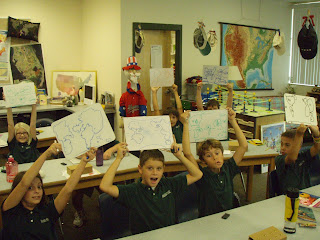Students read and discussed this document Thursday morning. It's long but I hope helpful.
Everyone reads independently on arrival each morning and then at various other times during the day. If you finish a lesson/activity earlier than others you are always encouraged to read. At morning unpack time (after silent/independent reading) students display for inspection all homework assignments and signed agendas.
We all share briefly what we’re reading each week. We mention the plot, characters and how we happen to choose this book in the first place.
The classroom runs smoothly because everyone has an assigned job for at least a trimester and many times the entire year. The jobs include managing the following: clipboards and slates, daily schedule and class reminder, front board and shelves, math gear, class logs (restroom sign out, independent reading and catch-up homework notebooks), computers/rolling lab manager, games, recess equipment, line leader, recycle and paper supply, pencils, science gear, library shelves and books, furniture/blinds/doors/lights, messenger and problem solver. Each student will turn in a card with his/her first three choices and reasons why.
The school honor pledge is our guide. The “Infractions Notebook” is where we keep track of the times students fail to respect themselves, others or the environment.
Recess and lunch are the times to socialize and relax. In the classroom conversation is mostly focused on lessons and projects with your table partner or study group.
Cubby trays are where you keep most of your learning materials. School supplies from home stay in your locker until needed. Your table shelves are where you keep your pencils and binder/agenda during the day.
Daily homework assignments are copied exactly from the board into your agendas. After school you share your completed homework with a supervising adult who signs the agenda indicating that it has been done.
If for any reason you are unable to complete your homework, you have the next recess time for catch-up. You need to sign the “class catch-up homework notebook” on arrival in the morning. You then put the homework you need to do in the recess homework catch-up basket.
Students sign in and out to use the restroom one at a time. There is no need to ask permission, just sign the notebook and lightly cross out your name when you return. The restroom sign out notebook is on a ledge of the teacher’s desk.
At morning unpack time, students put their lunches and snacks on the table by the hall door. To avoid injuries, all upper locker people put their book bags away first in the morning, then all the lower locker people. In the afternoon, all the people with lower lockers get their book bags first, then the upper locker people.
All students are expected to keep a water bottle with them. Water bottles are filled at morning unpack time and after PE if needed.
Fourth graders have a system of assigned tables for lunch which change monthly.
In class table partners are decided by the teacher. These are not permanent. You will move several times and have a variety of partners during the year.
We move about the school in an orderly, silent line. At the beginning of the year, there will be assigned places in line. Hold your questions/comments for the teacher until we are back in the classroom. Once everyone is seated the teacher will explain what’s next. All homework assignments are explained. You don’t need to ask.
In the classroom, please raise your hand if you have a question or want to participate in a discussion.
We gather on the rug next to the windows for a 10-15 minute snack break before recess. This is the time when the teacher or a student reads to the class or shares something of interest. Students wishing to share at snack time need to arrange with the teacher in advance.
All students are expected to reflect on what they did and learned each day. You will be taught how to make a list of the highlights of each day. This “daily reflection” is started in class and completed at home each evening.
Each Math unit begins with a family letter. Your are expected to review this letter with your supervising adults who then remove the Study Guide answer sheet to be used when they check your nightly math homework.
And finally a word about the school uniform. It's all spelled out in the parent/student handbook (now online) but I want to underscore that shirts are to be tucked in, belts worn (if the pants or skirts have loops) and shoes tied, period.
So that’s enough for now, but please go over all this at home.















